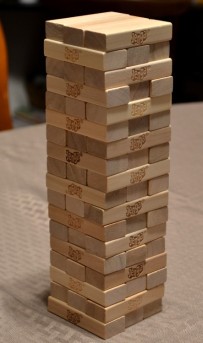Difference between revisions of "Homework4W15"
(→Jenga Simulator) |
(→Jenga Simulator) |
||
| Line 21: | Line 21: | ||
|} | |} | ||
</center> | </center> | ||
| + | |||
| + | ==Devices== | ||
| + | |||
| + | There is a Piazza poll for which device you would prefer to use. There are only a limited number of Hydras as well as zSpaces available - hopefully we can agree on a device distribution. Please fill out the poll by Monday evening (Feb 16th) so that we can hand out the Hydras on Tuesday. | ||
| + | |||
| + | Here are some pros and cons for each device: | ||
| + | |||
| + | Hydra: | ||
| + | + Teams can take it home with them. | ||
| + | + Two hand-held controllers allow for 2-handed interaction. | ||
| + | + The Hydra is a popular gaming controller which will soon be succeeded by the Sixense STEM system. | ||
| + | - No head tracking. | ||
| + | - The tracking of the Hydra controllers is quite accurate but not as accurate as the zSpace stylus (it is electro-magnetic). | ||
| + | |||
| + | zSpace: | ||
| + | + Excellent high definition stereo display. | ||
| + | + Very accurate optical tracking. | ||
| + | + Precise head tracking. | ||
| + | + A very accurate stylus is the controller. It has three buttons on it. | ||
| + | + zSpace computers have the free version of Unity installed. | ||
| + | + The zSpace is a professional VR display used in industrial, medical and educational environments throughout the world. | ||
| + | - Teams need to go to the instructor's laboratory to use it and time share the three systems. | ||
| + | |||
| + | The drivers for both devices, C++ API and Unity, are equally well implemented and documented and no issues are anticipated. Here are the driver links: | ||
| + | |||
| + | |||
| + | |||
| + | |||
<!-- | <!-- | ||
Revision as of 14:48, 14 February 2015
Jenga Simulator
This project is designed for use with either the Razer Hydra or the zSpace.
The Immersive Visualization Laboratory at the Qualcomm Institute made 3 zSpaces with Windows PCs available for the project. They will need to be time shared between the groups that use them.
The Razer Hydras will be distributed in class on Tuesday, February 17th.
There will be a homework discussion on Wednesday, February 18th at 4pm in CSE lab 220.
Jenga is a popular game in which players take turns removing one block at a time from a tower constructed of 54 blocks. Each block removed is then balanced on top of the tower, creating a progressively taller but less stable structure. The player who successfully removes and places the last block wins.

|

|
| Starting configuration | Mid-game configuration |
Devices
There is a Piazza poll for which device you would prefer to use. There are only a limited number of Hydras as well as zSpaces available - hopefully we can agree on a device distribution. Please fill out the poll by Monday evening (Feb 16th) so that we can hand out the Hydras on Tuesday.
Here are some pros and cons for each device:
Hydra: + Teams can take it home with them. + Two hand-held controllers allow for 2-handed interaction. + The Hydra is a popular gaming controller which will soon be succeeded by the Sixense STEM system. - No head tracking. - The tracking of the Hydra controllers is quite accurate but not as accurate as the zSpace stylus (it is electro-magnetic).
zSpace: + Excellent high definition stereo display. + Very accurate optical tracking. + Precise head tracking. + A very accurate stylus is the controller. It has three buttons on it. + zSpace computers have the free version of Unity installed. + The zSpace is a professional VR display used in industrial, medical and educational environments throughout the world. - Teams need to go to the instructor's laboratory to use it and time share the three systems.
The drivers for both devices, C++ API and Unity, are equally well implemented and documented and no issues are anticipated. Here are the driver links: